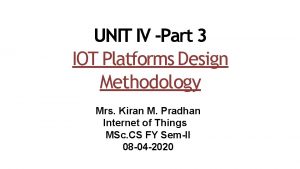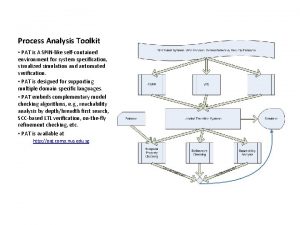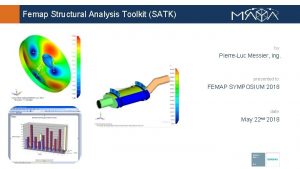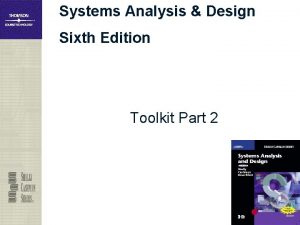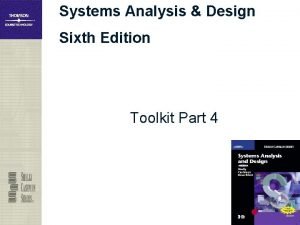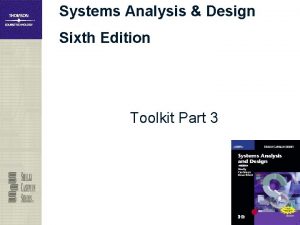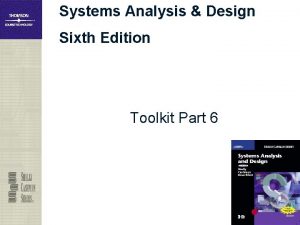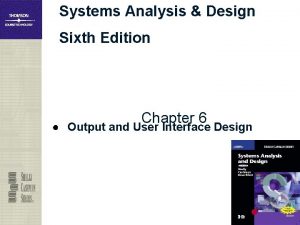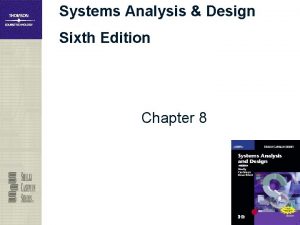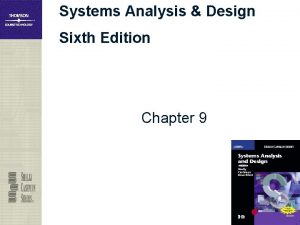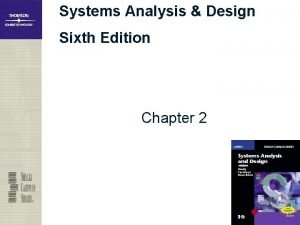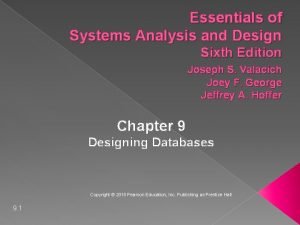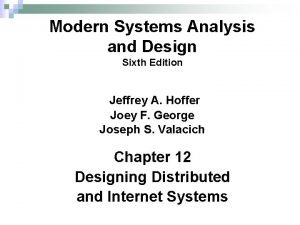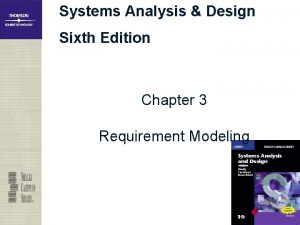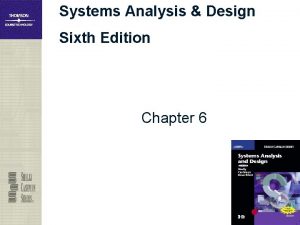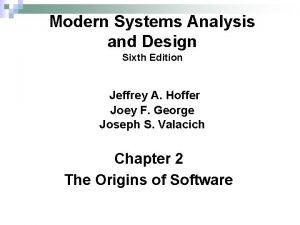Systems Analysis Design Sixth Edition Toolkit Part 3





















- Slides: 21

Systems Analysis & Design Sixth Edition Toolkit Part 3

Toolkit Objectives ● Define economic feasibility ● Classify costs and benefits into various categories, including tangible or intangible, direct or indirect, fixed or variable, and developmental or operational ● Understand chargeback methods and how they are used 2

Toolkit Objectives ● Use payback analysis to calculate the length of time that it takes for a project to pay for itself ● Use return on investment analysis to measure a project’s profitability ● Use present value analysis to determine the value of a future project measured in current dollars 3

Introduction ● You need to know how to calculate costs and benefits when you conduct preliminary investigations, evaluate IT projects, and make recommendations to management ● Financial analysis tools are important throughout the systems development life cycle 4

Describing Costs and Benefits ● You must review a project’s costs and benefits at the end of each SDLC phase so management can decide whether or not to continue the project ● Economic feasibility ● Total cost of ownership (TCO) 5

Describing Costs and Benefits ● Cost Classifications – – – – Tangible costs Intangible costs Direct costs Indirect costs or overhead expenses Fixed costs Variable costs Developmental costs Operational costs 6

Describing Costs and Benefits ● Managing Information Systems Costs and Changes – Chargeback method 1. No charge method • Cost center 2. Fixed charge method • Profit center 7

Describing Costs and Benefits ● Managing Information Systems Costs and Changes 3. Variable charge method based on resource usage • • • Resource allocation Connect time Server processing time 4. Variable charge method based on volume 8

Describing Costs and Benefits ● Benefit Classifications – – You must classify the benefits that the company expects from a project Like costs, benefits can be classified as tangible or intangible, fixed or variable, and direct or indirect Positive benefits Cost-avoidance benefits 9

Cost-Benefit Analysis ● Cost-benefit analysis ● Many cost-benefit analysis techniques exist ● Three most common methods: payback analysis, return on investment analysis, and present value analysis ● The objective is the same: to provide reliable information for making decisions 10

Cost-Benefit Analysis ● Payback Analysis – – Payback period Carry out the following steps 1. 2. 3. 4. Determine the initial development cost of the system Estimate annual benefits Determine annual operating costs Find the payback period 11

Cost-Benefit Analysis ● Payback Analysis – Economically useful life – Calculate the time it takes for the accumulated benefits of an information system to equal accumulated costs of developing and operating the system 12

Cost-Benefit Analysis ● Payback Analysis – Some managers are critical of it because it places all the emphasis on early costs and benefits and ignores the benefits received after the payback period – Even with its drawbacks, payback analysis is a widely used tool 13

Cost-Benefit Analysis ● Using a Spreadsheet to Compute Payback Analysis – First step is to design the worksheet and label the rows and columns – After entering the cost and benefit data for each year, you enter the formulas – You will need a formula to display cumulative totals, year by year 14

Cost-Benefit Analysis ● Return on Investment Analysis 15

Cost-Benefit Analysis ● Using a Spreadsheet to Compute ROI 16

Cost-Benefit Analysis ● Present Value Analysis – – – Time value of money Present value analysis Present value tables Net present value (NPV) 17

Cost-Benefit Analysis ● Present Value Analysis – In theory, any project with a positive NPV is economically feasible – Can also be used to compare and rank projects – Provides solutions to the shortcomings of payback analysis and return on investment analysis 18

Cost-Benefit Analysis ● Using a Spreadsheet to Calculate Present Value – There is one more way to use a worksheet in present value analysis – Most spreadsheet programs include a built-in present value function that calculates present value and other time-adjusted variable factors 19

Toolkit Summary ● Must be concerned with economic feasibility throughout the SDLC ● Must classify project costs as tangible or intangible, direct or indirect, fixed or variable, and developmental or operational ● Every company must decide how to charge or allocate information systems costs and the chargeback method 20

Toolkit Summary ● You also must classify system benefits ● Present value analysis adjusts the value of future costs and benefits to account for the time value of money ● Many companies use present value analysis to evaluate and rank projects ● Toolkit Part 3 complete 21
 Peter piper picked
Peter piper picked The sixth sick sheik's sixth sheep's sick lyrics
The sixth sick sheik's sixth sheep's sick lyrics Case tools are limited to systems analysis.
Case tools are limited to systems analysis. Modern systems analysis and design 7th edition
Modern systems analysis and design 7th edition Biochemistry sixth edition
Biochemistry sixth edition Computer architecture a quantitative approach sixth edition
Computer architecture a quantitative approach sixth edition Automotive technology principles diagnosis and service
Automotive technology principles diagnosis and service Automotive technology sixth edition
Automotive technology sixth edition Citation sample pdf
Citation sample pdf Computer architecture a quantitative approach sixth edition
Computer architecture a quantitative approach sixth edition Precalculus sixth edition
Precalculus sixth edition Rational people think at the margin
Rational people think at the margin Computer architecture a quantitative approach sixth edition
Computer architecture a quantitative approach sixth edition Iot system design methodology steps
Iot system design methodology steps Hamlet's sixth soliloquy
Hamlet's sixth soliloquy Using mis 10th edition
Using mis 10th edition Zulily case study
Zulily case study Process analysis toolkit
Process analysis toolkit Structural analysis toolkit for nastran
Structural analysis toolkit for nastran Systems analysis & design in an age of options pdf
Systems analysis & design in an age of options pdf Systems analysis and design in a changing world
Systems analysis and design in a changing world Systems analysis and design in a changing world
Systems analysis and design in a changing world













